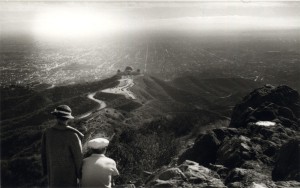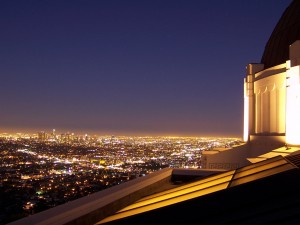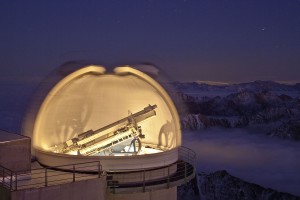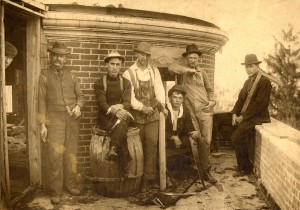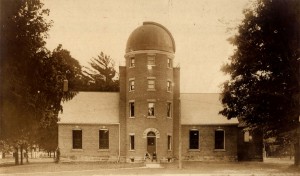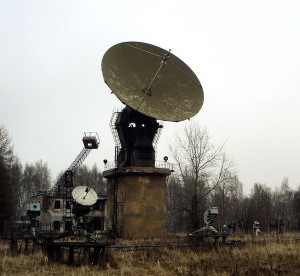
Griffith Observatory, February 25, 2012. Photo credit: JR
“The Griffith Observatory is not a highly technical or scientific institution. In other words, it is designed to appeal to the masses, and in operating the Observatory we shall strive to maintain the popular appeal and make it interesting and instructive, while the seientist and the student of research will also be fascinated by the opportunities offered.”
So said Mrs. Mabel V. Socha, President of the Board of Park Commissioners, Los Angeles, California, in her Address at the Formal Opening of the Griffith Observatory and Planetarium, May 14, 1935. Perched on the south side of Mount Hollywood, overlooking the light-polluted flats of the Los Angeles basin, Griffith Observatory is poorly situated for observational astronomy. It’s perfectly situated, however, for its intended function: educating and entertaining the masses. Easily accessible by car and almost as easily accessible by footpath, the observatory is open to the public five days a week, free of charge. FREE OF CHARGE.

Almost there. Photo credit: JR
Griffith is a model institution in terms of public outreach and astronomical education. Since its opening—courtesy of Colonel Griffith J. Griffith’s money and vision—the building has been anchored by a few key exhibits and instruments. Just inside the main entrance stands a Foucault Pendulum. Even as the building opened, however, its advocates must have realized that the pendulum would often take a back seat to its surroundings, as the ceilings and walls of the entrance rotunda are alive with color thanks to the murals of Hugo Ballin. As Mrs. Socha noted, “When you enter the foyer of the building your eyes behold the beautiful muraIs painted on the walls and ceiling by Mr. Hugo Ballin. The subjects chosen for his panels are very appropriate for this observatory and display the artistic ability of this famous artist. The coloring in the pictures and the perfect execution of the subject will excite your admiration and cause you to linger and absorb the beauty of these works of art.” The ceiling depicts Classical celestial mythology, while the wall panels celebrate the “Advancement of Science” with representations of astronomy, aeronautics, navigation, civil engineering, metallurgy and electricity, time, geology and biology, and mathematics and physics.
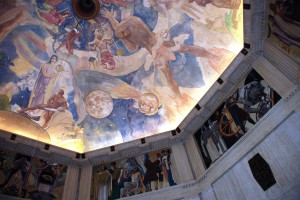
Hugo Ballin Murals, Griffith Observatory. Photo credit: JR
Also on the main floor, in the west rotunda of the Ahmanson Hall of the Sky, is a coelostat configured so its three mirrors feed separate solar telescopes.* When the sky is clear (it was mostly smoggy when I was there, the coelostat dome only opened after I started my hike below the observatory), visitors can study different aspects of the Sun through indirect observation. I super loved the Hall of the Eye, both for its exhibits on Observing in California and its Tesla Coil (who doesn’t love a good Tesla Coil?). There are more exhibits on the lower floor, including a 38-foot-diameter model of the moon and a fascinating section on meteorites in the California landscape. And of course, there’s the observatory’s central feature, the Samuel Oschin Planetarium.
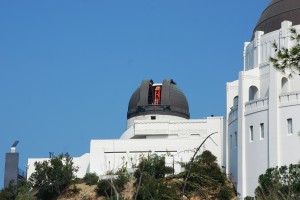
Open west dome with coelostat (left); Planetarium dome (right). Photo credit: JR
The best thing about Griffith Observatory has to be its public astronomy program, though. For daytime observing, there’s the coelostat. For nighttime observing, there’s the 12-inch Zeiss refracting telescope. That’s a good size for public viewing—even with LA’s light pollution, visitors can see the moon, planets and the brighter Messier objects. My own experience tells me that people who seldom look at the sky are completely blown away by the rings of Saturn and the moons of Jupiter, so you don’t need a huge telescope to give them a good show. The bigger the telescope the more time it takes to move around and refocus, anyway. The Zeiss was well worth $14,900 the Griffith Trust spent on it.

To Telescope. Photo credit: JR
The building itself owes a debt to the Beaux Arts; its floor plan and elevations are as symmetrical and formal as could possibly be. The original design called for more of a Mission flair, but the plans for terra cotta ornament were abandoned after the Long Beach earthquake in 1933. The observatory structure was shored up, its concrete walls thickened, and the ornamental program changed to something more in the spirit of the nearby Greek Theatre (also funded by Colonel Griffith J. Griffith). The building went under a major renovation in 2002 and is now a blinding white even on the smoggiest of days.

Greek meander. Photo credit: JR
I’ve uploaded a few more photos to my flickr site.
————-
*The dome and instrument extend above the main floor, but the viewing points are in the Hall of the Sky.







